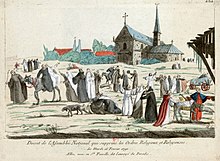Popes during the Age of Revolution
This article includes a list of general references, but it lacks sufficient corresponding inline citations. (October 2015) |
The modern history of the papacy is shaped by the two largest dispossessions of papal property in its history, stemming from the French Revolution and its spread to Europe, including Italy.
History
French Revolution

In 1793, a French diplomat in Rome,
Napoleonic Italy
In 1797
However, on 28 December of that year, a popular French general was killed in a riot outside the French embassy in Rome,
The new pope,
In 1804, Pius VII traveled to Paris to officiate at Napoleon's imperial coronation. On December 2, Napoleon crowned himself Emperor of the French in the Cathedral of Notre Dame, Paris, in the presence of Pope Pius VII.
But by 1808 relations had deteriorated. The pope annoyed Napoleon by refusing to sanction the annulment of his brother Jerome's marriage and, perhaps more significantly, by not bringing the ports of the Papal States into the Continental System.
French-occupied Rome
The result was that a French army occupied Rome in February 1808. In the following month another section of the papal states (the Marches) was annexed to the Napoleonic kingdom of Italy. Napoleon followed up these affronts by annexing in 1809 all that remains of the papal states, including the city of Rome, and by announcing that the pope no longer has any form of temporal authority. Pius VII responded by an immediate use of his spiritual authority, excommunicating Napoleon himself, albeit not by name, and everyone else connected with the annexation.
These are the events which brought the entire Italian peninsula under French control by 1809. The situation remained unchanged until after Napoleon's defeat at Leipzig in 1813 – an event followed by Austrian recovery of much of Italy and a subsequent seal of approval at the congress of Vienna.
Roman Republic
During the reigns of
Even before the Franco-Prussian War, Pius IX had foreseen the temporal power of the Church draining away and had begun redefining the Catholic Church as a spiritual power that would serve as a firm bulwark against the liberal trends of the period.[citation needed]
Theology
The First Vatican Council established clear theoretical underpinnings to Pius IX's commitment to an intensified centralization of ecclesiastical government in Rome. The council's companion definition of papal infallibility strengthened the energetic exercise of the papal magisterial power that was so marked a feature of the years between the first and second Vatican Councils. The pope's primary purpose was to obtain confirmation of the position he had taken in his Syllabus of Errors (1864), condemning a wide range of positions associated with rationalism, liberalism, and materialism, and to define the doctrine concerning the church. In the three sessions, there was discussion and approval of only two constitutions: Dei Filius, the Dogmatic Constitution On The Catholic Faith and Pastor Aeternus, the First Dogmatic Constitution on the Church of Christ, dealing with the primacy and infallibility of the bishop of Rome when solemnly defining dogma.
Seven months later, on 18 July 1870, the prelates assembled in St Peter's accepted an uncompromising dogma - that the pope, when speaking from his throne on a matter of faith or morals, is inspired by God and is therefore infallible. Papal infallibility was merely the most striking example of the authoritarian stance now being established. It must be said that most of the dissenting bishops had left Rome before the final vote. The direction in which Pius IX was taking the church was made very plain in a document of 1864 known simply as the Syllabus. It is a list of eighty modern errors that included such broad topics as socialism, civil marriage and secular education. The final error is the concept that 'the Roman Pontiff can and should reconcile himself to and agree with progress, liberalism and modern civilization'.
References
- ^ Hales, E.E.Y., Revolution and Papacy, Doubleday & Co., 1960
- ^ Hales, p.101.
- ^ Hales, p.113.
- ^ Hales, p.115.
- ^ Hales, p.128.
- ^ Hales, pp.139-154.
- ^ Hales, p.166.
- ^ Hales, p.189.
- ^ Hales, pp.190-193.
- ^ Hales, pp.222-223.
- Chadwick, Owen. 1981. The Popes and European Revolution. Oxford University Press.
- Hales, E.E.Y., Revolution and Papacy, Doubleday & Co., 1960.
- Hutton, William Holden. 1908. The age of revolution: being an outline of the history of the church from 1648-1815.
- Matsumoto-Best, Saho.2003. Britain and the Papacy in the Age of Revolution 1846-1851. Royal Historical Society.
- Pollard, John F. 2005. Money and the Rise of the Modern Papacy: Financing the Vatican, 1850–1950. ISBN 0-521-81204-6
